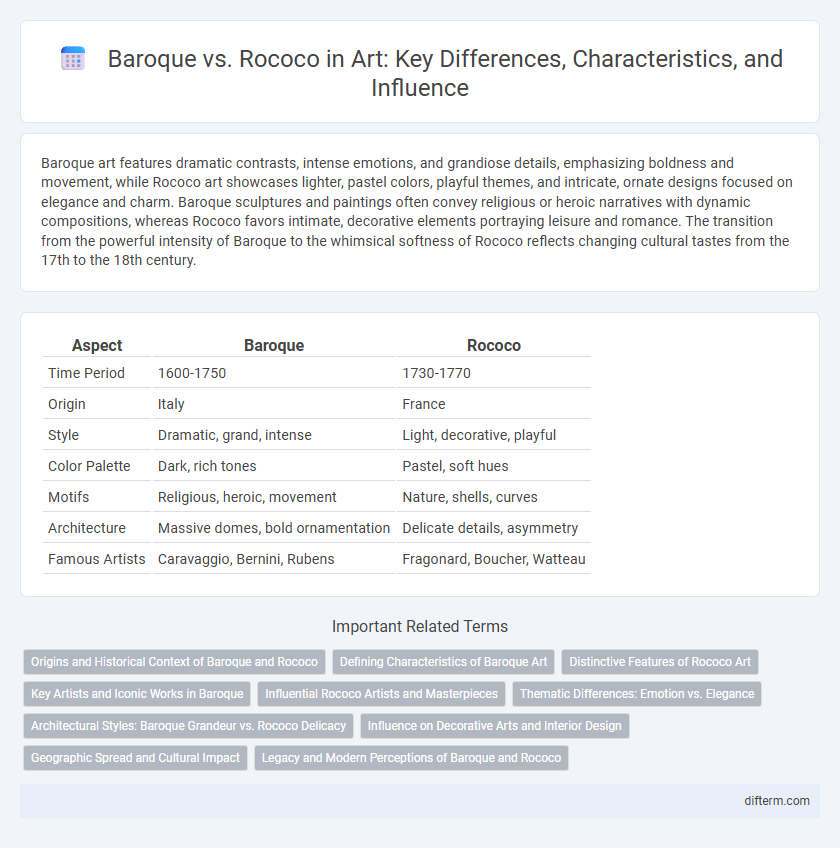Baroque art features dramatic contrasts, intense emotions, and grandiose details, emphasizing boldness and movement, while Rococo art showcases lighter, pastel colors, playful themes, and intricate, ornate designs focused on elegance and charm. Baroque sculptures and paintings often convey religious or heroic narratives with dynamic compositions, whereas Rococo favors intimate, decorative elements portraying leisure and romance. The transition from the powerful intensity of Baroque to the whimsical softness of Rococo reflects changing cultural tastes from the 17th to the 18th century.
Table of Comparison
| Aspect | Baroque | Rococo |
|---|---|---|
| Time Period | 1600-1750 | 1730-1770 |
| Origin | Italy | France |
| Style | Dramatic, grand, intense | Light, decorative, playful |
| Color Palette | Dark, rich tones | Pastel, soft hues |
| Motifs | Religious, heroic, movement | Nature, shells, curves |
| Architecture | Massive domes, bold ornamentation | Delicate details, asymmetry |
| Famous Artists | Caravaggio, Bernini, Rubens | Fragonard, Boucher, Watteau |
Origins and Historical Context of Baroque and Rococo
Baroque art emerged in early 17th-century Europe, fueled by the Catholic Church's Counter-Reformation efforts aiming to inspire faith through dramatic, emotional intensity and grandeur. Rococo developed in early 18th-century France as a reaction against Baroque's seriousness, emphasizing lightness, elegance, and playful themes that reflected the aristocratic society's tastes during the reign of Louis XV. Both styles represent distinct cultural responses to the political and religious climate of their respective periods, with Baroque rooted in religious fervor and Rococo in secular aristocratic excess.
Defining Characteristics of Baroque Art
Baroque art is characterized by dramatic use of light and shadow, intense emotions, and dynamic compositions that create a sense of movement. Rich colors, intricate details, and grandiose scale emphasize the power and grandeur typical of 17th-century Europe. Artists like Caravaggio and Bernini exemplified these traits, blending realism with theatricality to evoke awe and spirituality.
Distinctive Features of Rococo Art
Rococo art is characterized by its intricate ornamentation, pastel color palette, and playful themes of love and nature, distinguishing it from the dramatic intensity of Baroque. Curved forms, asymmetrical designs, and light-hearted subject matter, often depicting aristocratic leisure, define Rococo's decorative elegance. Delicate brushstrokes and a focus on light effects create a sense of movement and intimacy unique to Rococo masterpieces.
Key Artists and Iconic Works in Baroque
Caravaggio revolutionized Baroque art with his masterful use of chiaroscuro, exemplified in works like "The Calling of Saint Matthew," which emphasizes dramatic lighting and emotional intensity. Peter Paul Rubens is renowned for dynamic compositions and vibrant color palettes, as seen in "The Elevation of the Cross," capturing movement and grandeur. Gian Lorenzo Bernini's sculptural masterpieces, including "Apollo and Daphne," showcase the Baroque fascination with theatricality and intricate detail, setting a high standard for Rococo's later playful elegance.
Influential Rococo Artists and Masterpieces
Rococo art, characterized by its ornate elegance and playful themes, was shaped by influential artists such as Jean-Antoine Watteau, whose masterpiece "Pilgrimage to Cythera" epitomizes the movement's lightness and grace. Francois Boucher's works, including "The Birth of Venus," showcase the intricate detail and sensuality central to Rococo aesthetics. Jean-Honore Fragonard's "The Swing" captures the whimsical and flirtatious spirit that defines the contrast between Rococo and the more dramatic, bold Baroque style.
Thematic Differences: Emotion vs. Elegance
Baroque art emphasizes intense emotion and dramatic tension, evoking a powerful sense of movement and grandeur through bold contrasts and dynamic compositions. Rococo art, in contrast, focuses on elegance, lightness, and playful themes, with intricate details and pastel colors that highlight refined ornamentation and intimate scenes. These thematic differences reflect Baroque's grandeur and spiritual intensity versus Rococo's decorative charm and leisurely sophistication.
Architectural Styles: Baroque Grandeur vs. Rococo Delicacy
Baroque architecture is characterized by its dramatic grandeur, bold ornamentation, and dynamic forms, emphasizing contrast, movement, and grand scale to evoke awe and power. Rococo architecture, emerging as a lighter, more decorative evolution, features delicate curves, pastel colors, intricate details, and playful motifs that create an intimate and elegant ambiance. While Baroque structures often dominate urban landscapes with monumental facades, Rococo designs prioritize refined interior spaces rich in ornamental artistry and lightness.
Influence on Decorative Arts and Interior Design
Baroque art profoundly influenced decorative arts and interior design through its grandiosity, dramatic contrasts, and ornate details, inspiring heavy use of gold leaf, intricate carvings, and bold architectural elements in palaces and churches. Rococo evolved as a lighter, more playful reaction, favoring asymmetry, pastel colors, and intricate motifs such as shells and floral patterns that adorned furniture, mirrors, and wall paneling in aristocratic salons. Both styles shaped European interior aesthetics, with Baroque emphasizing theatricality and Rococo privileging elegance and whimsy in decorative design.
Geographic Spread and Cultural Impact
Baroque art, originating in early 17th-century Italy, spread extensively across Europe, influencing countries such as Spain, France, and the Holy Roman Empire with its dramatic intensity and grandeur, deeply intertwined with Counter-Reformation objectives. Rococo emerged in early 18th-century France as a reaction against Baroque's solemnity, spreading primarily through French aristocratic circles to Germany and Austria, characterized by ornamental elegance, lightness, and playful themes. The cultural impact of Baroque emphasized religious fervor and royal power projection, while Rococo shaped a shift toward secularism, intimacy, and the refinement of aristocratic leisure and aesthetics in European high society.
Legacy and Modern Perceptions of Baroque and Rococo
Baroque art is celebrated for its dramatic intensity, grandeur, and emotional depth, influencing modern cinematic visuals and theatrical design through its bold use of contrast and movement. Rococo is often associated with elegance, ornate detail, and playful themes, impacting contemporary interior design and fashion with its lightness and intricate decorations. Both styles continue to inspire artists and designers, reflecting the historical evolution of opulence and artistic expression in Western art.
Baroque vs Rococo Infographic

 difterm.com
difterm.com